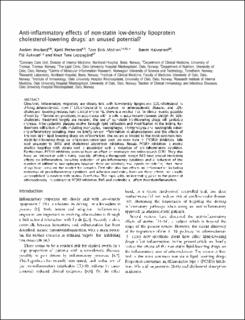| dc.description.abstract | Objectives. Inflammatory responses are closely knit with low-density lipoprotein (LDL)-cholesterol in driving atherosclerosis. Even if LDL-cholesterol is causative to atherosclerotic diseases and LDL-cholesterol lowering reduces hard clinical endpoints, there is a residual risk for clinical events, possibly driven by inflammatory processes, in accordance with its role in autoimmune diseases. Design. As LDL-cholesterol treatment targets are reduced, the use of non-statin lipid-lowering drugs will probably increase. Atherosclerotic plaques evolve through lipid infiltration and modification in the intima, furthermore infiltration of cells including monocytes, macrophages, T-lymphocytes and neutrophils initiating inflammatory signaling. Here we briefly review inflammation in atherosclerosis and the effects of the non-statin lipid-lowering drugs on inflammation. The review is limited to the most common non-statin lipid lowering drugs, i.e. proprotein convertase subtilisin-kexin type 9 (PCSK9) inhibitors, bile acid sequestrants (BAS) and cholesterol absorption inhibitors. Results. PCSK9 inhibition is mostly studied together with statins and is associated with a reduction of pro-inflammatory cytokines. Furthermore, PCSK9 inhibitors seem to have an effect on monocyte migration trough CCR2. They also have an interaction with sirtuins, possibly offering a therapeutic target. BAS have several interesting effects on inflammation, including reduction of pro-inflammatory cytokines and a reduction of the number of infiltrating macrophages, however there are relatively few reports considering that these drugs have been on the market for decades. Ezetimibe also has effects on inflammation including reduction of pro-inflammatory cytokines and adhesion molecules, however these effects are usually accomplished in tandem with statins. Conclusion. This topic adds an interesting piece to the puzzle of atherosclerosis, indicating that PCSK9 inhibition, BAS and ezetimibe all affect thromboinflammation. | en_US |
